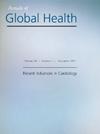Can Clean Delivery Kits Prevent Infections? Lessons from Traditional Birth Attendants in Nigeria
IF 3.2
4区 医学
Q2 PUBLIC, ENVIRONMENTAL & OCCUPATIONAL HEALTH
引用次数: 0
Abstract
Background: In resource-poor settings, perinatal infections contribute significantly to maternal and neonatal deaths, and the use of clean delivery kits (CDKs) has been proposed as a tool to reduce the risk of infection-related deaths. This study aims to assess the acceptability and effectiveness of CDKs in preventing infections in deliveries attended by traditional birth attendants (TBAs) in Abeokuta, Nigeria. Methods: The study was a cluster-randomized trial with 67 birth centres/clusters, 453 births/mothers, and 457 babies randomized to intervention or control arms; intervention involved supplementation of delivery with JANMA CDKs. Interviews were conducted at the birth homes, and the primary outcomes were neonatal infection and puerperal fever. The association between infection and perinatal risk factors was tested using the Chi-square and Fisher’s exact tests. Results: CDKs were well accepted by TBAs. The incidence of puerperal fever and neonatal infection was 1.1% and 11.2%, respectively. Concurrent infection was found in 1 (0.22%) of the mother-neonate pair. There was no significant association between any of the sociodemographic factors and infection for both mothers and neonates. PROM and prolonged labour were significantly associated with puerperal infection. All mothers with puerperal fever were from the control group. Compared to the control group, the relative risk of puerperal infection and neonatal infection in the intervention group was 0.08 (0.004 –1.35, p = 0.079) and 0.64 (0.37 to 1.1, p = 0.10), respectively. Conclusion: CDKs hold promising results in attenuating maternal infections in resource-poor settings. Larger studies with greater statistical power are required to establish statistically reliable information.清洁接生包能预防感染吗?尼日利亚传统助产士的经验教训
背景:在资源贫乏的环境中,围产期感染是导致孕产妇和新生儿死亡的重要原因,已提出使用清洁分娩包(CDKs)作为降低感染相关死亡风险的工具。本研究旨在评估CDKs在尼日利亚Abeokuta由传统助产士(TBAs)接生时预防感染的可接受性和有效性。方法:该研究是一项集群随机试验,有67个生育中心/集群,453名产妇/母亲和457名婴儿随机分为干预组或对照组;干预包括使用JANMA CDKs补充分娩。访谈在产房进行,主要结局是新生儿感染和产褥热。感染与围产期危险因素之间的关系采用卡方检验和Fisher精确检验。结果:CDKs被tba接受。产褥热和新生儿感染的发生率分别为1.1%和11.2%。同时感染1例(0.22%)。对母亲和新生儿来说,任何社会人口因素与感染之间都没有显著的关联。胎膜早破和产程延长与产褥期感染显著相关。所有出现产褥热的母亲均为对照组。与对照组相比,干预组产褥期感染相对危险度为0.08 (0.004 ~ 1.35,p = 0.079),新生儿感染相对危险度为0.64 (0.37 ~ 1.1,p = 0.10)。结论:CDKs在减少资源贫乏地区孕产妇感染方面具有良好的效果。要建立统计上可靠的信息,需要更大规模、更有力的研究。
本文章由计算机程序翻译,如有差异,请以英文原文为准。
求助全文
约1分钟内获得全文
求助全文
来源期刊

Annals of Global Health
PUBLIC, ENVIRONMENTAL & OCCUPATIONAL HEALTH-
CiteScore
5.30
自引率
3.40%
发文量
95
审稿时长
11 weeks
期刊介绍:
ANNALS OF GLOBAL HEALTH is a peer-reviewed, open access journal focused on global health. The journal’s mission is to advance and disseminate knowledge of global health. Its goals are improve the health and well-being of all people, advance health equity and promote wise stewardship of the earth’s environment.
The journal is published by the Boston College Global Public Health Program. It was founded in 1934 by the Icahn School of Medicine at Mount Sinai as the Mount Sinai Journal of Medicine. It is a partner journal of the Consortium of Universities for Global Health.
 求助内容:
求助内容: 应助结果提醒方式:
应助结果提醒方式:


